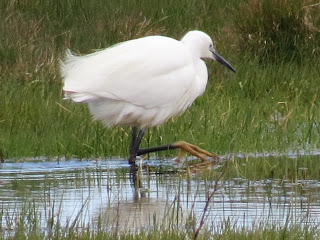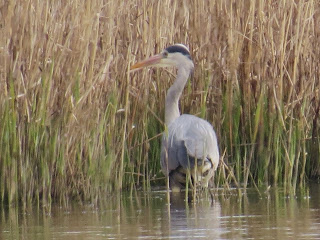 |
| Wryneck (my dodgy photo from Strumpshaw Fen, 2013) |
When my mum asked me if I wanted to go to Cley today, I lept at the chance. I have heard about some great birds in that area recently, including wrynecks! Wrynecks are unusual looking birds with cryptic camouflage and are sparrow-sized woodpeckers that prefer to spend most of the time on the ground, where they feed on ants. I have only seen one once before when one visited Strumpshaw for a few days along the river trail near the pumphouse in 2013. I didn't have my bridge camera back then, so I didn't get any great photos of it. Getting a photo of one today would have made up for it. Annoyingly, I couldn't find one today as it was playing hard to get in the gardens of houses up the road from the visitor centre. One house owner was kind enough to allow birders to come inside to see it in their garden for a small fee. By the time I got there, though, it was gone! Typical!
 |
| Sedge Warbler |
While the wryneck was a no show, there were other things to enjoy at Cley. Sedge warblers and whitethroats were singing in the bramble bushes and reedbeds close to the path, so close in fact that you are forced to walk up to them as we made our way to the central hides on the reserve. Sedge warblers especially appeared to be everywhere we went. We also had a bearded tit fly past us and a reed bunting singning in a bush close to the boardwalk leading up to the hides, while a kestrel was sitting on a telephone post and two sparrowhawks soaring high in the sky.
 |
| Whitethroat |
 |
| Kestrel |

 |
| Ruff with a white ruffed mane |
From the hides, waders were either feeding from the shallow pools or sitting on nests on the islands. Avocets were swishing their upturned bills across the surface of the water, catching tiny invertebrates with each swish. Godwits were looking at there best with their red breeding plumage, but for me nothing beats a ruff when they are fully fashioned with their various coloured breeding feathers. As with humans and hair colour, male ruffs vary from each other. Some are ginger, others white, brown, black or a mixture of everything. Most of the ruffs out on Pat's Pool were in different stages of the transformation to the final glamorous plumage. I could only find one male looking absolutely stunning with a red ruffed mane almost fully developed. After lunch, we walked along East Bank and found another male looking amazing, this time with a white ruffed mane.
 |
| Another Ruff |
 |
| Yet another Ruff |
 |
| Redshank |
 |
| Avocet |
 |
| Black-tailed Godwit |
 |
| Shoveler |
 |
| Little Egret |


 |
| Greenshank |
 |
| Curlew |
 |
| Chinese Water Deer |
 |
| Grey Heron |
 |
| Oystercatcher |
 |
| Skylark |
 |
| Shelduck |
 |
| Snipe |
Like I said, we went for a walk along East Bank, but not before a quick visit to Bishop's Hide to see a snipe get chased into a slither of reedbed in front of the hide by a lapwing. We could just about make out its head poking out of the reeds before it moved deeper within the vegetation. From East Bank, there were so many greylag goslings out on the field adjacent to the bank. They kept Mum occupied as she was counting how many there were. I think the conclusion was that there were a lot. They were all very young too, all small and fluffy. Mum was too busy going "aww!" to notice the spoonbill that was lurking within a deep channel a little further up. Occasionally, it would pop its white head out from the trench or completely out for us to have a good look at it before eventually flying west beyond the hides. We also saw a couple of little ringed plovers, but they were too far away to even bother getting photograph. It wasn't a bad day despite not seeing the wryneck, but the spoonbill and everything else more than makes up for it.
 |
| Greylag with goslings |
 |
| Spoonbill |





















































